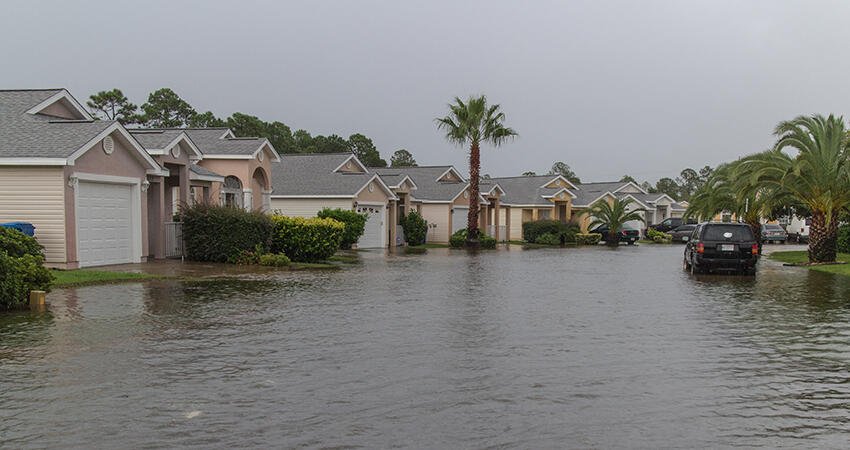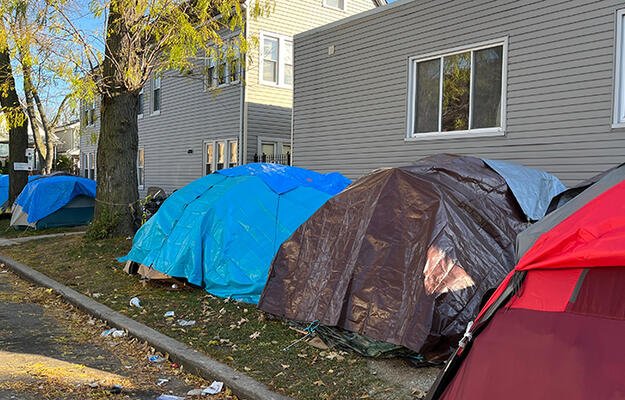
(johnmoorefour/Shutterstock)
Natural Disasters Lead to Increased Evictions
- Title:
-
A Perfect Storm? Disasters and Evictions
- Author:
-
Mark Brennan, Tanaya Srini, Justin Steil, Miho Mazereeuw, Larisa Ovalles
- Source:
- Publication Date:
-
2021
Climate change is increasing the frequency and severity of natural disasters like hurricanes, wildfires, and floods, which compounds housing instability challenges families face across the country. Renters with low incomes, who are disproportionately households of color, are especially vulnerable to disaster-related housing instability because of historic and ongoing racism that has limited access to financial resources, affordable housing, and even receipt of federal disaster assistance. In this study, researchers use a mixed-methods approach to examine the link between natural disasters and evictions and explore how local housing market conditions and federal assistance influence eviction trends within a county.
To understand the relationship between disasters and evictions, researchers created a county-level dataset spanning 2000 to 2015 that combines eviction filing and completion data from the Princeton Eviction Lab, severe climate disaster and damages data from Arizona State University, census data on county housing and socioeconomic characteristics, and publicly available data from the Federal Emergency Management Agency (FEMA) on FEMA filings and value of assistance to renters by county. The researchers supplemented the quantitative analysis with a qualitative case study of Panama City, Florida, and Bay County after Hurricane Michael in 2018. The researchers conducted 25 semistructured interviews with residents, public officials, property managers, social service providers, and legal aid and volunteer attorneys.
The study finds that severe natural disasters are associated with a substantial increase in evictions the year of and the year after a severe disaster. Post-disaster evictions are less likely in counties with lower median rents and in counties where renters received more federal assistance. These national trends held true in Panama City and the surrounding county, where severe damage to the local housing stock led to an increase in evictions and widespread displacement. The research makes clear that although the direct impact of a disaster may be brief, the consequences are enduring and the challenges renters face in accessing housing and maintaining housing stability continue for years.
National findings:
- The link between evictions and disasters: A severe disaster is associated with a statistically significant increase in evictions in the year of a disaster and the year following a disaster but is weakly associated with an increase in evictions two years after a disaster. The more costly the disaster, the more evictions were filed and completed.
- The effects of housing market conditions: Higher median rents and higher vacancy rates are associated with higher evictions rates after a disaster whereas higher median home values are associated with a small decrease in evictions. The authors hypothesize that in counties with high rents, tenants may already be cost burdened and have less of a financial cushion to deal with a disaster-related financial shock. They also suggest that high vacancy rates may be correlated with weaker local and individual economic conditions which may explain the association with increased evictions.
- The effects of federal assistance: Counties that receive more FEMA aid per renter household experience fewer evictions two years after a disaster. The authors hypothesize that FEMA aid in the 18 or more months following a disaster may help provide renters with a financial buffer to secure housing stability and avoid taking on high levels of debt in the immediate response to the disaster and as labor and housing markets recover.
Case Study of Panama City, Florida:
- In what was an already tight housing market, Hurricane Michael devastated housing availability for people with low incomes and led to the displacement of thousands of households. Of the 8,396 multifamily units in Panama City and the surrounding county, 4,623 were damaged by the storm.
- Significantly more evictions were filed in Bay County in 2018 than in previous years. The spike in evictions was driven by small landlords, who evicted 859 households in 2018, compared with a median of 711 evictions per year before 2018.
- Small landlords with fewer resources struggled to obtain financing and find contractors to make repairs, leaving their renters with uninhabitable units or facing eviction. They often had trouble accessing federal resources because they lacked clear title to the land.
- Larger landlords with more resources sometimes took advantage of the disaster to evict renters, make repairs, and increase rents, consistent with prior analyses.
- Displaced renters had trouble finding affordable units, given rising prices caused by increased demand and reduced supply. Renters who had been evicted faced additional difficulties in finding new housing because of their eviction record. The increase in evictions also affected landlords, who noted many units remained vacant for longer because of the rental restrictions to households with an eviction filing.
- Subsidized renters were viewed as abandoning their voucher if they left, but those who stayed had trouble finding a unit under the fair-market rent limit given the increased cost of rental units.
- Almost all residents had problems with mold in their units immediately following the storm, and many reported mold and mildew issues were lower priorities for landlords than pressing structural damage.
- Respondents suggested the storm reinforced housing inequalities along racial lines, as many people of color lacked the resources to evacuate before the storm or relocate outside of North Florida after the storm and were stuck in Panama City in cycles of housing instability.
Policy implications
- To break the link between disasters and evictions, the authors suggest that policymakers consider interventions like disaster-related eviction moratoria, a right to counsel for tenants, or changes to court procedures during disasters. Where preventative eviction measures are not possible, the authors posit disaster-related evictions should be expunged from tenants’ records and that automatic expungement policies in disaster contexts might be particularly appropriate.
- Information is a critical tool for reducing postdisaster evictions for both tenants and landlords. The authors suggest that government agencies and service providers ensure landlords and tenants understand the laws and are aware of available resources as they navigate a postdisaster recovery.
- The authors note the right to counsel for tenants facing eviction, which cities such as New York provide, is particularly important because the landlords are better equipped to navigate court proceedings. Currently, FEMA’s Disaster Legal Services program, which provides free legal help to disaster survivors with low incomes, does not reach some of the most precarious renters.


